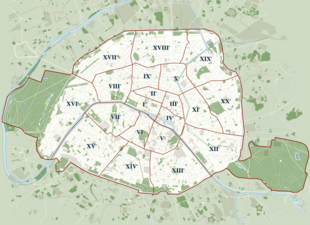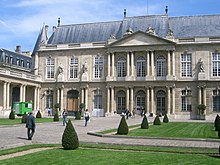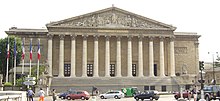Hôtel particulier in Paris

The Hôtel particulier, a specifically French type of city palace, plays an important role in the cityscape of Paris . Starting from Paris, this type of building developed particularly in the 16th and 17th centuries. In the districts of Marais , Faubourg Saint-Honoré and Faubourg Saint-Germain there are a large number of these art-historically important city residences from the period from the late 15th to the 18th century.
Marais
The Hôtel de Carnavalet is located at 23 Rue Sévigné in the Marais district . The early construction history of the hotel has not yet been fully clarified.
Construction began in 1544–1548 for Jacques des Ligneris , President of Parliament . As a sculptor, Jean Goujon was involved in the construction. The attribution of the design is not clear. Come into consideration jean bullant , Jacques Androuet du Cerceau the Elder and Pierre Lescot . Lescot is favored as the author due to some stylistic features.
In 1578 the hotel was sold to François de Baume Dame de Kernevenoy by the son Théodore de Ligneris. The name "Carnavalet" for the hotel was derived from the corruption of his family name .
In the 17th century the hotel was fundamentally rebuilt twice. The first remodeling was probably carried out for Florent d'Argouge by François Mansart in the second or third decade of the century.
The second renovation began after the heirs were sold to Claude Boislève in 1654. This renovation was also carried out by François Mansart and the sculptor Gérard Van Opstal . After Boislève lost his influence at the court, the hotel changed hands again in 1661. It was sold and rented between 1677 and 1696 by Marie de Rabutin-Chantal, Marquise de Sévigné .
It was then inhabited by Etienne Brunet de Rancy and, until 1775, by Nicolas-François Dupré de Saint-Maur .
After the French Revolution, the hotel housed the École Nationale des Ponts et Chaussées .
In 1866 the building was acquired by the city of Paris. The hotel was renovated and expanded between 1871 and 1890 and is now home to the Musée Carnavalet for the history of Paris.
The facades of the hotel have largely been preserved. The inner structure was heavily reshaped by the conversion to a museum. It is no longer recognizable in its original concept.
Hotel Salé
The Hôtel Salé was built between 1656 and 1659 by the little-known architect Jean Boullier de Bourges for the tax collector Pierre Aubert de Fontenay. It derives its name from the fact that the client had enriched himself by collecting the salt tax. Salé means salted. The Hôtel Salé has housed the Musée Picasso since 1985 .
Hotel de Sens
The Hôtel de Sens is located in the Marais . Together with the Hôtel de Cluny, it is the oldest still preserved aristocratic palace. The Archbishop of Sens had the building erected in 1475–1507 after his elevation to Primate of Gaul. As with the Hôtel de Cluny, the basic concept of this building corresponds to a Gothic city castle; Details such as the window arrangement already suggest the Renaissance .
Gate of the Hôtel de Clisson
Of the Hôtel de Clisson, which was built between 1371 and 1375 for the connoisseur Olivier de Clisson (1336-1407), a brother-in-arms of Duguesclin (1320-1380), only the fortified gate, flanked by two towers, remained. From 1553 the hotel was owned by the Guisen . Her heirs sold it in 1705 to François de Rohan , Duke of Soubise (1630-1712). He had the Hôtel de Soubise, explained below, built on the site, but kept the portal of the Hôtel de Clisson as a side entrance.
Hotel de Soubise
The Hôtel de Soubise emerged from the Hôtel de Clisson and dates in this form from the 18th century. The ensemble has been owned by the state since 1808 and houses the Archives Nationales (State Archives).
Hotel de Sully
The Hôtel de Sully was built between 1625 and 1638.
Faubourg Saint-Germain
Hôtel d'Étampes / Hôtel de Mazarin
The Hôtel d'Étampes at 61 rue de Varenne ( 7th arrondissement ) was redesigned in 1703 by Jean Courtonne for Cherestien-Francois de Gorge d'Entraigues . 1729 reshaped Germain Boffrand and Claudius III. Audran the hotel again. After the change of ownership in 1736, it was renamed the Hôtel de Mazarin . The Duchesse de Mazarin and her cousin Marie-Anne de Mailly-Nesle (1717–1744) commissioned the architect Jean-Baptiste Leroux to redesign the interior . The sculptor Nicolas Pineau and the painters François Boucher , Jacques de Lajoue , Charles-Joseph Natoire and Christophe Huet were involved in the decoration .
In addition to the decorative changes to the facades and the interior in the Rococo style , the courtyard in front of the Corps de Logis was closed to the street by a newly built transverse building. A carriage door was presented to this building . The enfilade, the previous access system for the apartments , was abandoned and replaced by the principle of free circular access to the rooms. In 1745 Jacques-François Blondel praised the Hôtel de Mazarin as exemplary to his students at the École des Arts .
In 1826 half of the building was demolished when Rue Vaneau was built. The architect Jean-Joseph Rougevin subsequently rebuilt part of the building.
Hotel Matignon
The Hôtel Matignon in the Rue de Varenne No. 57 ( 7th arrondissement ) had Christian-Louis de Montmorency, prince de Tingry (1675–1746), son of the Maréchal de Luxembourg (1628–1695), by the architect Jean in 1720 Build Courtonne . It replaced a residence previously owned by the Baron de Pouancé. Today it serves as the official residence of the French Prime Minister.
Hotel de Rochechouart
The Hôtel Rochechouart, a typical Parisian Hôtel particulier between the courtyard and the garden, was commissioned by the Marquise de Courteille in 1776 on a property with today's house number 110 in the Rue de Grenelle ( 7th arrondissement ) by the court architect Mathurin Cherpitel for her only daughter, the Countess of Rochechouart. This sold it in 1804 to Charles François Augereau, Duke of Castiglione, Maréchal and Peer of France. His widow left it to the university in 1829, whereupon the newly founded Ministry of Education (then ministère de l'instruction publique ) settled there. Since then, the Hôtel Rochechouart has been the seat of the ministry responsible for education (now the ministère de l'éducation nationale ).
In the years from 1838 to 1892, the architect Alphonse de Gisors , among others , carried out several additions, extensions and conversions, and the buildings on Rue de Bellechasse (numbers 54 and 56) and Rue de Grenelle to expand the Ministry (Numbers 108 and 112) bought up.
The 18th century Corps de Logis has been a listed building since 1993. Noteworthy are the two facades facing the courtyard and the garden, as well as the Grand Salon doré (currently the Minister's office) with its intact Louis-seize furnishings and the so-called "small office". The Grand Salon doré , the office of Maupassant , who was appointed attaché in the cabinet of the Minister in 1878, and the Salon Julie Daubié were restored in 2002.
Hotel de Roquelaure
The Hôtel de Roquelaure is located at 246 Boulevard Saint-Germain in the arrondissement . It was built between 1695 and 1724. One of the architects involved was Jean Lassurance (1690–1755), who rebuilt the Élysée Palace , among other things . The interiors were designed in the Rococo style.
Faubourg Saint-Honoré
Place Vendôme
The Place Vendôme was built from 1688 in honor of King Louis XIV according to the design of the architect Jules Hardouin-Mansart . The palaces around the square, equipped with uniform facades , were built until 1720. In the middle of the square is the 44-meter-high Colonne Vendôme, named after the square, from the years 1806 to 1810.
Hotel de Charost
The Hôtel de Charost is located at 39 Rue du Faubourg Saint-Honoré in the 8th arrondissement . In 1722, the captain of the Garde du corps du roi Chevalier du Saint-Esprit Paul-Francois de Béthune-Charost acquired one of the properties near the newly built Hôtel d'Évreux , today's Élysée Palace , on Rue du Faubourg Saint-Honoré . From 1722 to 1726 his father Armand II. De Béthune had the Hôtel de Charost built on it. The execution was the responsibility of Marseille coming Antoine Mazin . The hotel included the apartments for Armand II. De Béthune, as well as those of his younger son, Paul François de Béthune, and his daughter-in-law. Until 1784 the hotel was used by the members of the Charost-Béthune family.
In 1784 the building was leased to the Count de La Marck and redesigned between 1787 and 1791. After the lease expired, the property returned to the Duke in 1793. His widow leased the hotel in 1800 to the British Ambassador Charles Whitworth, 1st Earl Whitworth, who was accredited to the French First Republic . Another renovation took place until 1803.
Shortly after the ambassador's expulsion, the hotel became the property of Napoleon's sister Pauline Bonaparte . At the instigation of Pauline Borghese, the hotel was redesigned after 1804 by Pierre-François-Léonard Fontaine and Besnard. The Empire - style interior was based on the Hôtel de Beauharnais (now the residence of the German ambassador), which was owned by Napoleon Bonaparte's stepson , Eugène de Beauharnais . In 1814 the hotel and its inventory were sold and used by the Duke of Wellington , the city commandant of Paris. Since 1815 the Hôtel de Charost served as the British embassy in France.
Hotel de Crillon
The Hôtel de Crillon at Place de la Concorde No. 10 is part of the west of the two palaces that Jacques-Ange Gabriel designed as the northern border of this square to the Faubourg Saint-Honoré . However, Gabriel only created the facade (from 1757) and left it to the architect Louis-François Trouard , who acquired the property behind, to design the actual Hôtel particulier according to his own needs. He rented the city palace in 1776 to the Duke of Aumont († 1782) and after his death in 1788 sold it to the Duke of Crillon, whose family took him to 1907, with an interruption caused by the confiscation during the Revolution inhabited. In that year the Hôtel de Crillon was renovated by the "Société des grands magasins et hôtels du Louvre" and has since been home to one of the most luxurious hotels in the world.
Hôtel Saint-Florentin or Hôtel Talleyrand-Périgord
The Hôtel Saint-Florentin on Rue Saint-Florentin No. 2 on the northeast corner of the Place de la Concorde ( 1st arrondissement ) was built by the French architect Jean-François Chalgrin for Louis Phélypeaux de Saint-Florentin , State Secretary from 1767 to 1769 Louis XVI. He had acquired the site from the financier Samuel Bernard . The city palace came into the possession of Talleyrand († 1838) in 1812 and was bought after his death by Baron James de Rothschild (actually Jakob Mayer Rothschild), the youngest of the five Rothschild brothers and founder of the French family branch. His descendants had the Hôtel Saint-Florentin rebuilt from 1860 to 1870 by the architects E. Petit and Léon Ohnet and decorated with boiseries from the pavilion of Madame du Barry in Louveciennes and from 1948 rented it to the government of the United States , which there George C. Marshall Center before purchasing it in 1950. Today the building, which has been a listed building since 1981 and has been restored thanks to the American World Monuments Fund , is the seat of the Consulate of the United States in Paris.
Hotel de Pontalba
The Hôtel de Pontalba at 41 Rue du Faubourg Saint-Honoré in the 8th arrondissement was built by Louis Visconti for the Baroness von Pontalba between 1836 and 1842 and acquired by Edmond de Rothschild in 1876 . He had it heavily rebuilt by the architect Félix Langlais , with valuable boiseries from the Hôtel Samuel Bernards (No. 46 in Rue du Bac) and the Hôtel Peyrenc de Moras (now the Musée Rodin ) being reused for the furnishings.
The building has been owned by the United States government since 1948. It has served as the ambassador's residence since 1966 .
Latin Quarter
Hotel de Cluny
The Hôtel de Cluny is located in the Latin Quarter . Together with the Hôtel de Sens, it is the oldest surviving city palace. The abbot of the important Cluny monastery had the building built between 1485 and 1490. A Gothic town castle from the basic concept , details such as the window arrangement are already in the spirit of the Renaissance .
Today the Musée national du Moyen Âge , the museum for medieval art, is housed here. It shows exhibits such as the windows of the Sainte-Chapelle , sculptures from Notre-Dame , and pictorial works such as the "Lady with the Unicorn".
The ruins of the ancient thermal baths are directly adjacent and partially integrated into the museum .
Further
Hotel de Thellusson
The Hôtel de Thellusson was commissioned by Marie-Jeanne Girardot de Vermenoux (1736–1781), the widow of the banker Georges-Tobie de Thellusson (1728–1776), by Claude Nicolas Ledoux at 30 rue de Provence (now 9th arrondissement ). It went to her death into the possession of her son over, then to Joachim Murat (1802) and Napoleon Bonaparte (1807), which is the Russian Tsar Alexander I gave. It was demolished in 1824.
Hotel Beauharnais
The Hôtel Beauharnais was built by Germain Boffrand for Jean-Baptiste Colbert, marquis de Torcy in 1714 and bought by Eugène de Beauharnais in 1803 . Today it is the residence of the German ambassador in Paris.
Palaces
Palais du Luxembourg
The Palais du Luxembourg was built after the death of King Henry IV between 1612 and 1620 as the widow's residence of Maria de Medicis . The design comes from Salomon de Brosse . See also: Jardin du Luxembourg
Palais Royal
The Palais Royal was built between 1634 and 1642 by the architect Jacques Le Mercier for Cardinal Richelieu and today it houses the French Ministry of Culture, among other things .
Bourbon Palace
The Palais Bourbon was built from 1722 for a daughter of King Louis XIV , the Duchesse de Bourbon . The seat of the French National Assembly , the lower house of parliament, has been located there since 1826 .
See also
- List of Hôtels particuliers in Paris (Monument historique)
- Hôtel de Lauzun (also Hôtel Pimodan ), at times the home of the poets Charles Baudelaire and Théophile Gautier
literature
- Françoise Boudon: Urbanisme et Speculation à Paris au XVIIIe Siècle: Le Terrain de l'Hôtel de Soissons . In: The Journal of the Society of Architectural Historians . Society of Architectural Historians, 1973.
- Rosalys Coope: John Thorpe and the Hôtel Zamet in Paris . In: The Burlington Magazine . The Burlington Magazine Publications, 1982.
- Julia Droste-Hennings, Thorsten Droste: Paris. DuMont, Cologne 2003, ISBN 3-7701-6090-8 .
- Norbert Elias: The courtly society . Studies on the sociology of royalty and the court aristocracy with an introduction: sociology and history . Luchterhand, Neuwied 1969.
- Dietrich Feldmann: The Hôtel de La Vrillière and the rooms "a l'italienne" at Louis Le Vau . In: Journal for Art History . German art publisher, 1982.
- Michel Gallet: Paris Domestic Architecture of the 18th Century . London: Barrie & Jenkins 1972.
- Goode, William O. 2000. Moving West: Three French Queens and the Urban History of Paris. In: "The French Review". American Association of Teachers of French.
- Junecke, Hans. 1960. A 17th century renovation project for the Hôtel Carnavalet. In art history journal . German art publisher.
- Fiske Kimball : The Creation of the Style Louis XV. In: The Art Bulletin . College Art Association, Inc. Published by College Art Association. 1941
- Kingsley, Rose; Gronkowski, Camille. 1903. Types of Old Paris Houses. Article I.-Hôtel de Lauzun, Louis XIV. Period. In: The Burlington Magazine for Connoisseurs . The Burlington Magazine Publications.
- Neuman, Robert. 1980. French Domestic Architecture in the Early 18th Century: The Town Houses of Robert de Cotte, In: The Journal of the Society of Architectural Historians . Society of Architectural Historians.
- Parker, James. 1969. The Hotel de Varengeville Room and the Room from the Palais Paar: A Magnificent Donation. In: The Metropolitan Museum of Art Bulletin . New Series, The Metropolitan Museum of Art.
- Perry, Rachel. 2001. François-Joseph Belanger's Bath-House at the Hôtel de Brancas. In: Architectural History . Essays in Architectural History Presented to John Newman. SAHGB Publications.
- Tooth, Constance. 1967. The Early Private Houses of Louis Le Vau. In: The Burlington Magazine . The Burlington Magazine Publications.
- Heinfried Wischermann: Architecture Guide Paris. Gerd Hatje, Ostfildern 1997. ISBN 3-7757-0606-2









